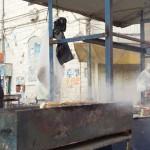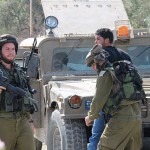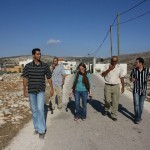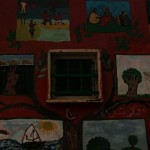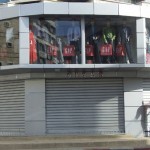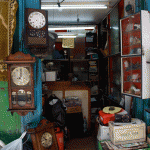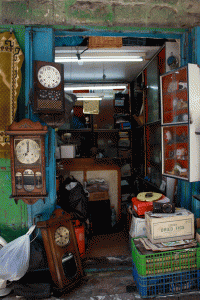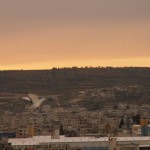
Read original article on the Palestinian News Agency website.
JERUSALEM, July 31, 2010 (WAFA)- UN Office for the Coordination of Humanitarian Affairs  (OCHA)- occupied Palestinian territory, said that Israeli authorities demolished 17 structures in Area C of the West Bank this week on grounds of “lack of permit.â€
In its weekly Protection of Civilians report, OCHA said that ten structures were located in Al Lubban Al Gharbi village (Ramallah governorate), and included two newly built houses (not yet inhabited), two animal shelters, a stand for selling vegetables, a car repair workshop and a car wash.
OCHA added that eight families (80 members including 38 children) reported losing their primary source of income or their entire life savings. Of the remaining structures demolished, two (a room and an animal shelter) were located in the village of Bani Na’eim (Hebron governorate) and five (fruit and vegetable stalls) near Al Jalama village (Jenin governorate), affecting 14 people. Five houses and one animal shelter in the town of Idhna (Hebron governorate) and another seven animal shelters in Beit Nuba village (Ramallah governorate) were issued stop-work orders.
This week’s demolition of structures follows the demolition of 86 structures in Area C last week in the Jordan Valley and southern West Bank.
The spate of demolitions raises concerns over whether Israeli authorities could further escalate demolitions throughout Area C, particularly following a commitment to that effect given by the Israeli Civil Administration to the Israeli High Court of Justice, and recently reported in the Israeli media. According to official Israeli figures, there are more than 3,000 outstanding demolition orders throughout Area C.
OCHA continued on saying that currently, it is nearly impossible for Palestinians to obtain building permits to maintain, repair or construct homes, animal shelters or necessary infrastructure in Area C. Since the beginning of 2010, Israeli authorities have demolished 199 Palestinian-owned structures in Area C, (more than half of which were demolished in July) and displaced 242 people. In comparison, 182 structures were demolished and 319 persons displaced in the equivalent period in 2009.
Also this week, the Jerusalem Municipality demolished three plant nurseries, a shop for selling construction materials, and a car wash in an area of Hizma village included within the unilaterally-declared municipal boundaries of Jerusalem. A total of 65 people, including 49 children, were affected, the report continued.
Israeli forces killed one Palestinian and injured ten others this week, including five children. Eight Palestinians and two members of the Israeli forces have been killed in the context of the Palestinian- Israeli conflict so far this year, compared to 14 Palestinians and two Israeli military force members killed in the equivalent period in 2009.
OCHA added that, this week, Israeli forces wounded four foreign nationals and one Israeli activist in weekly protests against the construction of the Barrier in the villages of Bil’in (Ramallah governorate) and Al Ma’sara (Bethlehem governorate); against the access restrictions to agricultural land near the settlement of Karmei Zur (Hebron governorate); and against the ban on Palestinian travel on the main commercial street in H2 area of Hebron City.
Israeli forces conducted 82 search and arrest operations inside Palestinian towns and villages compared to a weekly average of 99 operations since the beginning of 2010.
Settler violence witnessed a marked escalation this week, particularly in the northernWest Bank. OCHA documented 12 incidents involving Israeli settlers that resulted in either Palestinian injuries or damage to Palestinian property. A total of 161 such incidents have taken place in 2010 to date, resulting in one Palestinian child killed, and 60 other Palestinians injured. The same period last year witnessed approximately half that figure. A number of incidents involving prevention of access, intimidation and trespassing by Israeli settlers were also reported during the week. According to Palestinian media source, four settlers were injured during clashes between Palestinians and settlers in the village of ‘Iraq Burin (Nablus governorate), OCHA went on.
Five of this week’s incidents reportedly occurred in the context of the “price tag†strategy, where Israeli settlers retaliated for the demolition of two structures by the Israeli Civil Administration in an outpost near Bracha settlement (Nablus). In one incident, one Palestinian from Burin village was wounded in clashes with Israeli settlers after the latter set fire to agricultural land and damaged an area of approximately 2,000 dunums (estimated by Palestinian sources) planted with olive trees and vegetables. In a separate incident in the same area, settlers set fire to a few hundreds of dunums of Palestinian fields and stoned Palestinian-plated vehicles causing minor damage. In addition, settlers from the Elon Moreh settlement (Nablus governorate) installed caravans on Palestinian agricultural land in Deir al Hatab, causing damage to the land planted with wheat and legumes.
In southern Hebron, one man from the hamlet of Khirbet Bir al ‘Idd was injured by Israeli settlers who physically assaulted him while en route to a water well nearby. In 1999-2000, some 20 families residing in this community were forced to evacuate their homes and stay with relatives, following repeated attacks from settlers. Last year, residents returned to their homes after an agreement was reached between the residents and the Israeli army mediated through an Israeli human rights organization, OCHA added.
According to the local council of Safa village (Ramallah governorate), tens of dunums of land belonging to the village, partly planted with olive trees, were burnt, allegedly by Israeli settlers. The land concerned is on the western side of the Barrier, between the Barrier and the Green Line. The Palestinian fire brigades managed to access the location and extinguish the fire only after lengthy coordination procedures between the Palestinian and Israeli District Coordination and Liaison offices.
Concerning tha Gaza Strip, OCHA said that this week, Israeli forces killed three Palestinians and injured seven others near the fence between Israel and the Gaza Strip. In addition, a 14 year-old boy was injured when an Unexploded Ordnance (UXO) exploded in the area of Beit Lahiya. In 2010, 38 Palestinians (including 12 civilians), three Israeli soldiers and one foreign national have been killed in the context of the Palestinian-Israeli conflict in the Gaza Strip and southern Israel. Another 147 Palestinians (including 130 civilians) and five Israeli soldiers have been injured.
On 21 July, Israeli troops fired a number of tank shells at an open area in the outskirts of the town of Beit Hanoun, a few hundred meters from the fence. Two men were killed, at least one of whom was an armed militant, and seven bystanders were injured, including four children aged between 6 and 9 years. Five houses sustained damage and two shells landed without exploding and were later collected by the local police. According to Al Mezan Center for Human Rights, some of the shells fired in this incident were flechette shells, which explode in midair and release thousands of metal darts in a conical arch up to three hundred meters long and about ninety meters wide, it explained
OCHA elaborated that in a separate incident the following day, Israeli forces targeted a group of armed Palestinians in the vicinity of the fence, east of Khan Younis, killing one. On three occasions during the week Israeli forces entered a few hundred metres inside Gaza and withdrew after leveling land.
All above incidents took place in the context of a wider policy implemented by the Israeli military aimed at preventing and discouraging Palestinian access to areas up to 1,000-1,500 meters from the perimeter fence, OCHA said air strikes in the Gaza Strip also continued. The Israeli Air Force targeted and hit an alleged military base and several tunnels under the Gaza-Egypt border, resulting in no injuries. Palestinian armed factions continued firing a number of rudimentary rockets towards southernIsrael, resulting in no injuries or damage.
Tunnel situation remains dangerous
Gaza crossings imports continue to increase however impact remains limited.
OCHA stated that the number of truckloads allowed into Gaza continues to increase following the 20 June 2010 announced Israeli decision to ease the Gaza blockade. A total of 979 truckloads entered Gaza between 18 and 24 July constituting a 77 percent increase compared to the weekly average of 553 truckloads that entered in 2010, prior to the announcement. However, this week’s figure only represents 35 percent of the weekly average of truckloads that entered Gaza during the first five months of 2007 (2,807), before the tightening of the blockade.
New items allowed entry this week included raw materials for the local biscuit production industry and air conditioners. Despite the increase in the variety of items allowed into Gaza since the announced ease on imports, food items continue to make up the majority of imported goods (69 percent).
Since the new Israeli measures do not specifically include the lifting of current restrictions on exports from Gaza, the scale of economic activity remains heavily dependant on domestic demand, which in
turn is constrained by the low purchasing power of the population and the relatively small size of the local market. Until crossings are opened for export, the impact of the new measures on unemployment.
There was a significant decline this week in industrial fuel imports needed to operate the Gaza Power Plant compared to last week (0.83 vs. 1.45 million litres). This week’s figure represents 26 percent of the actual estimated weekly amount of fuel (3.15 million litres) required for the power plant to operate at full capacity. As a result, the majority of the population in Gaza continues to experience power cuts 8 to 12 hours per day, according to OCHA.
Similarly, imports of cooking gas declined; 781 tonnes were imported this week compare to 969 tonnes last week. This week’s imports represent 62 percent of the average weekly needs (1,400 tonnes) estimated by the Gas Station Owners Association (GSOA). As the cooking gas shortfall continues, the rationing scheme introduced by the GSOA in November 2009 remains in place, it concluded.

